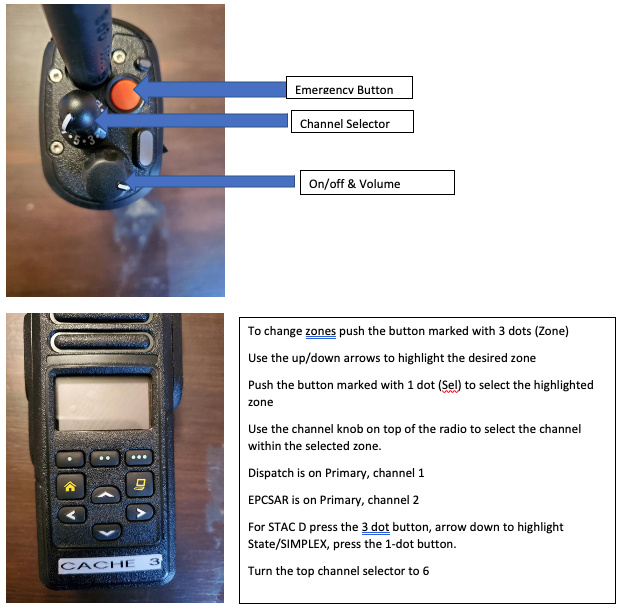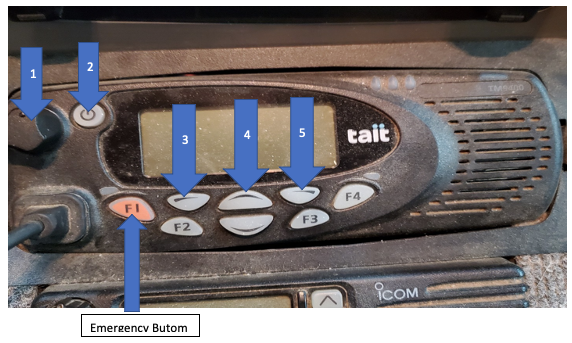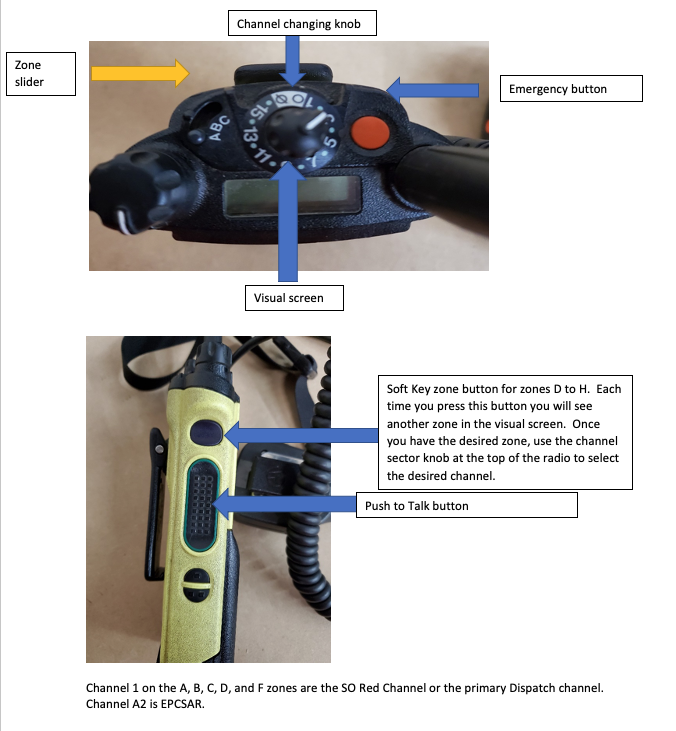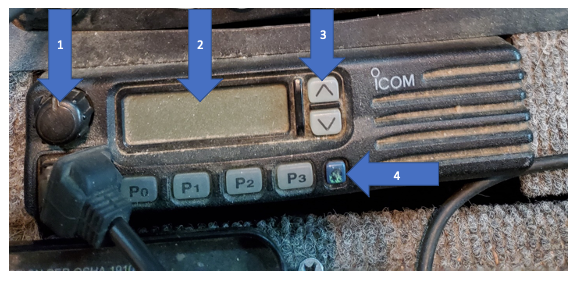800 MHz and VHF Radio Operating Instructions
Introduction
EPCSAR utilizes both the 800 MHz and VHF for communications. All EPCSAR vehicles have a mobile 800 MHz radio, an assigned 800 MHz handheld radio, and a VHF mobile radio. EPCSAR members generally carry their own VHF radio. Field Team Leaders and On Duty Coordinators (ODC) carry an assigned 800 MHz HT (Handheld Transceiver) radio as well.
All vehicles have a Tait 800 MHz mobile radio and a mobile iCom VHF radio. All the mobiles (800 and VHF) are of the same make and model so operate the same regardless of the vehicle in which it is mounted.
There are zones and channels on all radios. There are 14 zones programmed into our 800 MHz radios (A, B, C, D, E, F, G, H, I, J, K, L, M, N). All 800 MHz radios are programmed so that each zone has 16 channels.
All 800 MHz radios have a Red Emergency button (sometime referred to as the Bob button). Pressing this button allows you to notify Dispatch of a life-threatening situation if you are unable to call Dispatch on the Red Channel (A1) or the IC/ODC. This could be an accident in which you are injured or a situation in which someone is threatening you. Dispatch is immediately notified of an emergency button activation and a dispatcher is dedicated to work the emergency button activation until the situation is resolved. If you accidently push the red button, you MUST contact the SO Dispatch on the A1 (Red Channel) and notify them of the accidental activation. Turning the radio off will not stop Dispatch from following up on the activation.
There are 16 VHF channels on 1 zone. Some are repeated (e.g. 1, 4) and some are direct (2, 5, 7).
800 MHz Digital Trunked Radio
There are currently 3 types of 800 MHz HTs in our inventory that are the Motorola APX 4000, Motorola APX 7000 (cache radios), and the Tait TP9400 (generally FTL, ODCs, etc). The HTs permanently assigned to all the vehicles are Motorola APX 4000. The APX 4000 are easy to use with all zones changed via the soft (front) keys. The APX 4000 are programmed identical to the Tait mobile radios in the vehicles.
The 800 MHz radios are a trunked system. This means that when you press the “push to talk” button you must wait for the system to register the “call”. This happens when you hear the “beep”. Talking before you hear the beep will mean that those words were not transmitted. Sometimes you’ll hear a “bonk” noise when you key the mic. This means that the system is busy and to try again in a few seconds. This “bonk” will also occur when you are out of the trunked systems range. A persistent beeping noise (single beep about every 30 seconds) indicates your battery is low.
Motorola APX 4000 (Radios assigned to each vehicle)

800 MHz Tait Mobile (Vehicle) Radios

#1: Volume knob
#2: On/off button
#3: Select button (once you get to the correct zone)
#4: Move up or down through zones and channels
#5: Push to change zones
F1: Emergency Button
F2:
F3: Scan on and off
F4:
To change zones, push #5, use the up/down #4 button until you are at the correct zone, push #3 to select this zone. Use the up/down #4 buttons to change channels within that zone
The APX 4000s HTs and the Mobile vehicle radios have identical programming.
Note that STAC D is on SMPX channel 1 on both the mobile and the APX 4000s
The 700 zones listed above are not normally used in El Paso County but are interoperable channels used in other Counties such as Douglas County.
APX 7000 Handheld Radio (HT)
The APX 7000s are cache radios and operate differently than the APX 4000s:

These radios operate slightly different than the Motorola APX 4000 that are in all the vehicles. The primary difference is in the changing of channels. The A, B, C zones are changed by using the selector switch on the top of the radio (marked as 3-way selector on the diagram). To change to zones D through H you must use the “soft key button” on the side of the radio. This soft button is the round black button on the side of the radio at the top.
Zones A, B, and C: To change between these 3 zones on the HTs you slide the zone bar (top of radio) to the correct A, B, or C position and then use the channel changing knob on the top of the radio to choose the correct channel.
Zones D and above: This requires that you use the zone bar on top of the radio (A, B, C slider) in conjunction with the “soft” button on the side of the radio. The following zones can be reached using the soft button in conjunction with the A, B, C slider:
With the top slider in the A position and the soft button you can get to zones D, G, J, and M
With the top slider in the B position and the soft button you can get to zones E, H, K, and N
With the top slider in the C position and the soft button you can get to zones I, L, N, F
Above the channel changing knob is a small slider. One direction places the radio on scan and the other direction places the radio off scan. If you see a “z” type emblem at the top of the visual screen it means the radio is on scan. This means you will hear all talk on all radio channels including the Red Channel (SO primary dispatch channel).
The APX 7000s are programmed slightly different than the APX 4000s and the Tait mobile radios.
Note that STAC D (FFL, Memo Star) is located on Zone H, channel 6. To get to H6 place the top A, B, C selector switch to the B position, use the soft key button on the side of the radio to locate the H Zone, turn the top channel selector knob to the 6 position.
Tait TP9400 Controls
This radio is of the same programming of the Motorola vehicle mobile radios (and the APX 4000). Use the A, B, C zone selector for those zones and then use the channel knob at the top of the radio. For zones above C, push the menu button to get to zones, use the arrow up and down buttons to select the desired zone, push the Select button, use the channel knob to select the desired channel.
You use the soft keys on the front to move to other zones on this type radio which are:
EPSO/AMR: All LE channels and AMR
CSFD: CSFD channels
Fire Dept H-Z: County FDs such as Hanover, Tri-Lakes, Tri-County, and all fire departments with the appropriate H-Z letter. All the other fire departments are on the B channel under Fire A-G (e.g. Broadmoor, BFFD, Falcon, etc)
State: Mac channels 1-16 (keep in mind that Mac 1 and Mac 2 are often referred to a CSAR 1 and CSAR 2. 1 is the repeated channel and 2 is the direct channel).
State/SCR: These are interoperable channels Mac 17-21, CSP and SCR channels
SMPX: Identical to the mobile radios with SMPX Zone and Channel 1 is STAC D for helo operations.
VHF Mobile Radios
The VHF radios in all the vehicles are of the same model, make, and manufacturer. The iComs are loaded with 16 channels on 1 zone. There are no other zones. Push #4 to turn on/off. To change a channel, push the up/down arrow buttons (#3) until you get to the correct channel which will be visible in the screen (#2). Turn the volume knob (#1) to increase or decrease volume.

The mobile radios are programmed with SAR specific channels. These include other SAR units and MRA channels (both repeated and direct). The VFIRE21 is also an FFL/Memo Star channel. While FFL/Memo Star can be contacted by either VHF or 800 MHz they normally use STACD on the 800. If using VFIRE21 you must contact the IC who will ensure that the helo is on the correct radio/channel.
The VHF radios do not have an emergency button.
VHF Program Channels
| Channel | RX (MHz) | TX (MHz) | RX Decode (CTCSS) | TX Encode (CTCSS) |
| 1 Main Repeater | 151.295 | 159.315 | 167.9 | 167.9 |
| 2 Main Direct | 151.295 | 151.295 | 167.9 | 167.9 |
| 3 MRA1 Direct | 155.160 | 155.160 | – | 156.7 |
| 4 MRA2 Repeater | 155.235 | 150.775 | 151.4 | 151.4 |
| 5 MRA2 Direct | 155.235 | 155.235 | – | 151.4 |
| 6 VTAC 17 Repeater | 161.850 | 157.250 | – | 156.7 |
| 7 TAC Direct | 155.205 | 155.205 | 151.4 | 151.4 |
| 8 EPC Portable Repeater | 155.625 | 151.1975 | 151.4 | 151.4 |
| 9 EPC Direct | 155.625 | 155.625 | 151.4 | 151.4 |
| 10 VLAW31 Direct | 155.475 | 155.475 | – | 156.7 |
| 11 VFIRE21 Direct | 154.280 | 154.280 | – | 156.7 |
| 12 Cheyenne Repeater | 155.250 | 159.0375 | 151.4 | 151.4 |
| 13 PIKE Direct | 171.1375 | 171.1375 | – (CSQ/no tones) | 110.9 |
| 14 VCALL10 Direct | 155.7525 | 155.7525 | 156.7 | 156.7 |
| 15 TCSAR Direct | 155.175 | 155.175 | – | 179.9 |
| 16 DCSAR Direct | 155.205 | 155.205 | – | 127.3 |
Note:
Helo Opns on VHF is Channel 11 (VFIRE 21)
MRA 1 and MRA 2 may also be called CSAR 1 and CSAR 2.
Teller Co may not be using 155.175 as they are in the process of transitioning to Ham radios.


